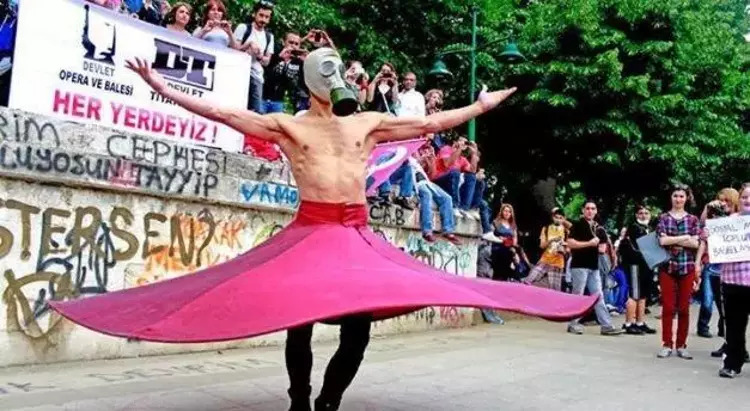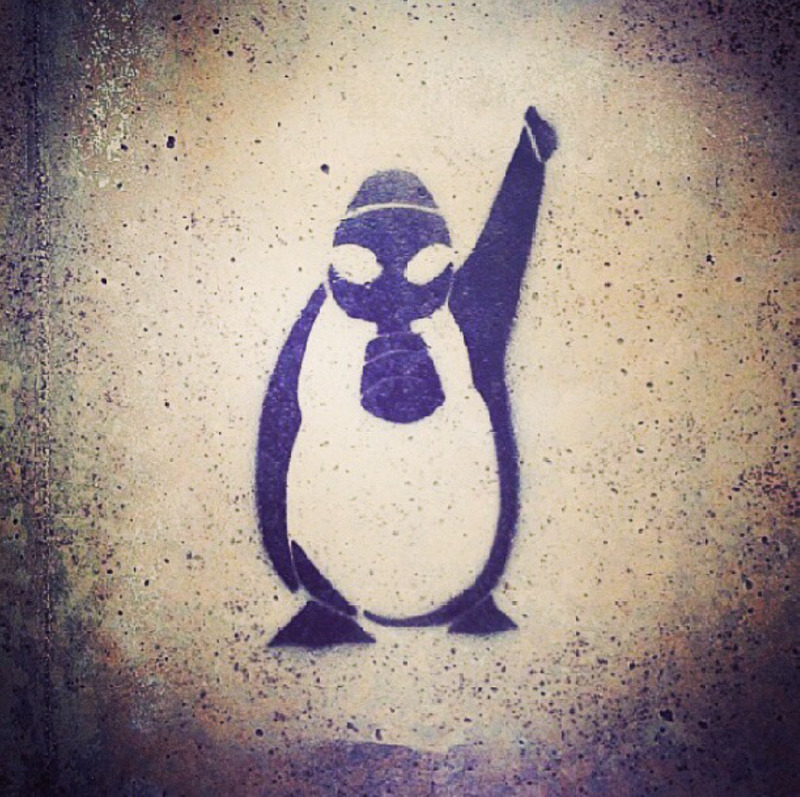Tear Gas
Throughout the protests, police frequently deployed tear gas and pepper spray to disperse the crowds. The practice has been criticized as indiscriminate and a potential health hazard for people with certain medical conditions.The practice was criticized for being indiscriminate, being a potential health hazard for people with certain conditions.
Over time, people got used to the gas and developed tactics to deal with it. One of these methods was to wear a gas mask. The masks quickly became one of the symbols of the protests. They were put on different characters in artistic renditions to indicate their support for the Gezi movement.
Another iconic tactic was to squeeze lemons onto affected people's eyes to neutralize the tear gas with acid. Some people began preparing lemon juice sprays at home to apply quickly to those in need, as a sort of field medic.
All images
-
 Dancer with gas mask and a pink skirt The photo shows a dancer with a skirt resembling that of a semazen, but in pink and a decidedly feminine style. They are also wearing a gas mask. A large crowd has gathered around to watch the performance.
Dancer with gas mask and a pink skirt The photo shows a dancer with a skirt resembling that of a semazen, but in pink and a decidedly feminine style. They are also wearing a gas mask. A large crowd has gathered around to watch the performance. -
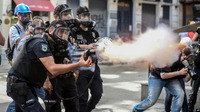 Police firing tear gas Police fire tear gas at demonstrators near Taksim Square.
Police firing tear gas Police fire tear gas at demonstrators near Taksim Square. -
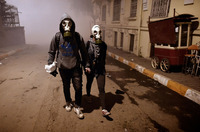 Couple with gas masks The photo shows a couple with gas masks walking on a street from Beşiktaş to Taksim.
Couple with gas masks The photo shows a couple with gas masks walking on a street from Beşiktaş to Taksim. -
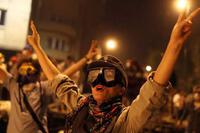 Protesters making victory sign The photo shows two protesters in front of a bigger group. They are wearing gas masks and making the victory sign with both hands.
Protesters making victory sign The photo shows two protesters in front of a bigger group. They are wearing gas masks and making the victory sign with both hands. -
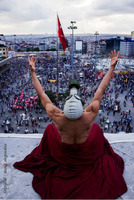 The Whirling Dervish with the Gas Mask The photo shows a person with a semazen (Sufi whirling dervish) costume on top of a structure overlooking Taksim Square. The person is also wearing a gas mask, connecting the traditional and peaceful image of a semazen to the protestors.
The Whirling Dervish with the Gas Mask The photo shows a person with a semazen (Sufi whirling dervish) costume on top of a structure overlooking Taksim Square. The person is also wearing a gas mask, connecting the traditional and peaceful image of a semazen to the protestors. -
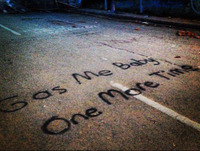 Gas Me Baby One More Time The graffiti plays with the lyrics of the popular song "...Baby One More Time" (Britney Spears, 1999) to produce a sarcastic and provocative message.
Gas Me Baby One More Time The graffiti plays with the lyrics of the popular song "...Baby One More Time" (Britney Spears, 1999) to produce a sarcastic and provocative message. -
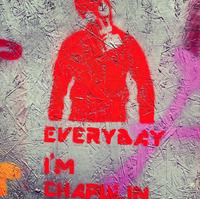 Everyday I’m chapulin The graffiti references the lyrics "Every day I'm shufflin'" from the popular song "Party Rock Anthem" by LMFAO. It connects the lyrics with the image of a "chapuller" with a gas mask.
Everyday I’m chapulin The graffiti references the lyrics "Every day I'm shufflin'" from the popular song "Party Rock Anthem" by LMFAO. It connects the lyrics with the image of a "chapuller" with a gas mask. -
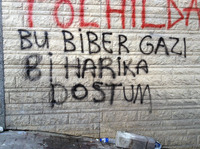 Bu biber gazi bir harika dostum This ironic graffiti jokingly calls out the tear gas use by the police.
Bu biber gazi bir harika dostum This ironic graffiti jokingly calls out the tear gas use by the police. -
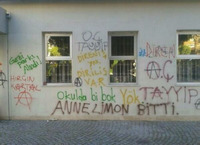 Wall of Graffiti This wall has been sprayed with many graffiti, presumably by multiple people. Two of the graffiti call out "O.Ç Tayyip", "O.Ç" being a common initialism for "child of a bitch" in Turkish and Tayyip being Erdoğan's unpreferred name. The yellow graffiti in the middle says "There's no resistance, only (re-)birth". The brown text in the bottom says "Mom we have no more lemons.", humorously referring to the use of lemons to counter the effects of tear gas. The red graffiti with the anarchy symbols says "aggressive eagle", presumably referring to the mascot of the football team Beşiktaş and its fan group Çarşı.
Wall of Graffiti This wall has been sprayed with many graffiti, presumably by multiple people. Two of the graffiti call out "O.Ç Tayyip", "O.Ç" being a common initialism for "child of a bitch" in Turkish and Tayyip being Erdoğan's unpreferred name. The yellow graffiti in the middle says "There's no resistance, only (re-)birth". The brown text in the bottom says "Mom we have no more lemons.", humorously referring to the use of lemons to counter the effects of tear gas. The red graffiti with the anarchy symbols says "aggressive eagle", presumably referring to the mascot of the football team Beşiktaş and its fan group Çarşı. -
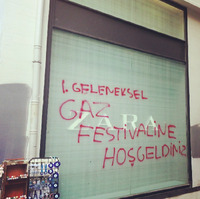 1. Geleneksel Gaz Festivaline Hoşgeldiniz This graffiti jokingly addresses the excessive use of tear gas by the police by framing it in a carnivalesque manner. It arguably delineates the situation humorously to alleviate the deterrent effects of police violence on protesters.
1. Geleneksel Gaz Festivaline Hoşgeldiniz This graffiti jokingly addresses the excessive use of tear gas by the police by framing it in a carnivalesque manner. It arguably delineates the situation humorously to alleviate the deterrent effects of police violence on protesters. -
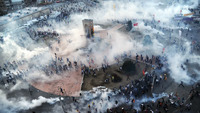 Taksim Square on June 11
Taksim Square on June 11 -
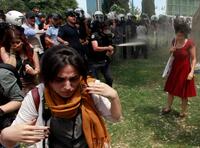 Woman in Red (Ceyda Sungur) The photo was taken during the initial occupation of Gezi Park. Police officer Fatih Zengin is seen attacking a protester with pepper spray. The victim is Ceyda Sungur, an academician at Istanbul Technical University at the time. This photo became one of the most iconic images of Gezi, showing police brutality and riling up people in the early days of the resistance. It won the "Press Photo of the Year" award of the Turkish Photojournalists Association in 2014.
Woman in Red (Ceyda Sungur) The photo was taken during the initial occupation of Gezi Park. Police officer Fatih Zengin is seen attacking a protester with pepper spray. The victim is Ceyda Sungur, an academician at Istanbul Technical University at the time. This photo became one of the most iconic images of Gezi, showing police brutality and riling up people in the early days of the resistance. It won the "Press Photo of the Year" award of the Turkish Photojournalists Association in 2014.






